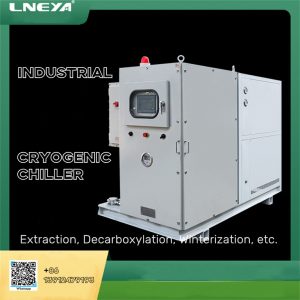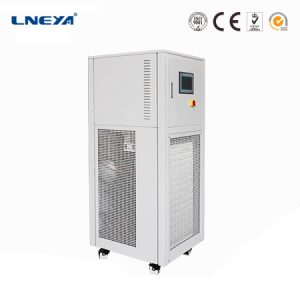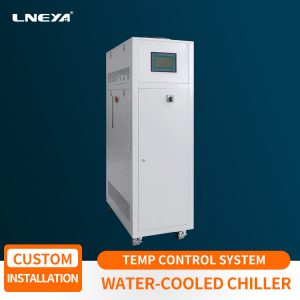Método de mantenimiento del sistema de refrigeración a temperatura ultrabaja
En ultra low temp chiller refers to the refrigeration unit whose chilled water temperature reaches below minus 35℃. The unit adopts two-stage compression refrigeration, and the combination of the scroll compressor and the piston compressor is used to manufacture a freezing source of minus 35℃ or even minus 60 ℃, to meet the requirements of the production process, to ensure the normal and smooth production.
Firstly, the leak detection of ultra low temp chiller system.
1. The refrigerant side of the unit has undergone a strict leak detection process during the factory and commissioning process.
2. After the unit is running, check the high-pressure part with the leak detector to ensure the tightness of all connections.
3. If a leak is found, it should be disposed of immediately. In general, the connection of the nano or flange bolts can be used to eliminate the leaks, but there is also the possibility that the refrigerant be recovered and then the leaks must be treated. Such as the leakage of welded joints.
Second, the system’s pressure leak detection.
The standard pressure leak detection steps for ultra low temp chillers are as follows:
1. Fill a small amount of R-22 gas to a system pressure of 2PSIG.
2. Fill the system with nitrogen to 25~50 PSIG. Make sure the pressure reaches all parts of the system. The oil valve can be opened slightly, and the leak detector is used to check whether there is refrigerant.
3. Check each joint and weld, and try to be careful and spend as much time as possible. The leak detection equipment used must be sensitive and reliable.
4. Open the top bleed valve of the evaporator and condenser to confirm that no refrigerant has been detected. If refrigerant is found, the end cap should be removed to remove the internal leak.
5. Confirm that the system is completely sealed, and the gas is released from the system at an appropriate flow rate from the filling valve to perform a certain purging action.
Thirdly, vacuuming and drying of ultra-low temperature chiller system.
1. Connect the high efficiency vacuum pump and the mercury vacuum gauge in series with the filling valve of the system.
2. Open all valves of the system that connect the valve, the suction valve and the vacuum gauge. Confirm that all valves that pass through the atmosphere are closed.
3. Start the vacuum pump and pump the vacuum to 5mmHg.
4. If there are conditions, 50oC of hot water can be introduced into the system to accelerate the evaporation of the system’s memory and improve the dryness.
Recomendaciones relacionadas
-
Several elements of the operation of -20 degree industrial cryogenic chiller
1924-20 degree industrial cryogenic chiller is a refrigeration equipment that provides low temperature chilled water. It is often used in production enterprises, such as chemical companies, pharmaceutical companies and other production processes, to p...
Ver detalles -
Equipment attention points of laboratory high and low temperature cycle equipment manufacturers
1708In the laboratory, a wide range of experimental instruments are widely used. When the experimental instruments are in operation, they are inseparable from the high-low temperature circulating device refrigeration heating equipment. What should be ...
Ver detalles -
Hot and cold dynamic constant temperature control equipment cryopump installation points
1801The performance of each component in the cold and heat source dynamic constant temperature control equipment is different. We must make full use of each accessory to make the equipment run better. The cryopump is one of the main accessories, and i...
Ver detalles -
Análisis de causas del efecto de enfriamiento deficiente de la enfriadora por agua
1462Las enfriadoras de agua se utilizan cada vez más en todos los ámbitos de la vida. Su función principal es suministrar agua refrigerada industrial para equipos o productos. El rango de temperatura del agua puede ajustarse en función de las necesidades del usuario, y...
Ver detalles
 LNEYA Enfriadoras industriales Fabricante Proveedor
LNEYA Enfriadoras industriales Fabricante Proveedor














